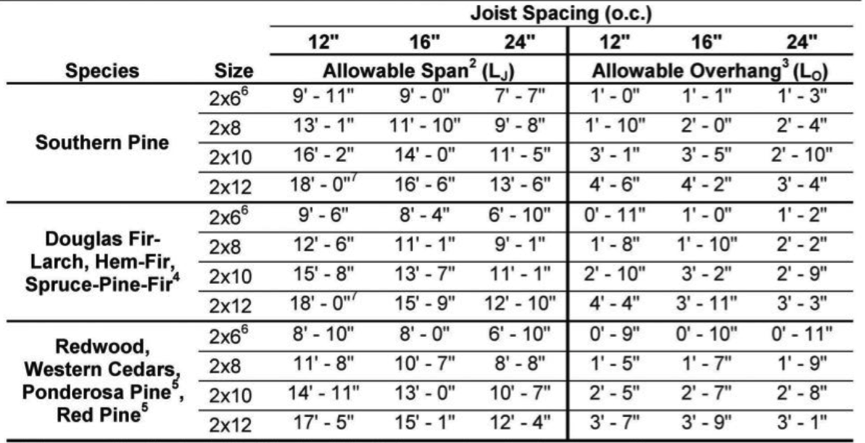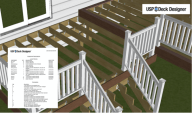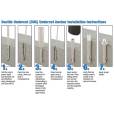The American Wood Council’s free guide offers a trusted reference to understanding the 2012 International Residential Code (IRC). But why does the IRC code need an additional guide? The reason is simple: The IRC gets updated, but much of the legacy code remains in place. So, a supplemental guide will point out what’s new, and in this case, the American Wood Council’s guide focuses on single-level wood deck construction in residential homes. Entitled “DCA 6: The Prescriptive Residential Wood Deck Construction Guide” (available for download at this link), this document—just 44 pages long—sorts through the operative deck code today. In this article, we will cover: joists, cantilevers, tension tie-downs, footing options, and glulams.
Joists and Cantilevers: While the code still requires that a 2×8 be used for attaching guard posts, 2×6 joists are allowed for deck joists. Figure 1 shows the appropriate span tables, even showing allowable overhangs for 12, 16, and 24-inch joist spacing for 2x6s (as well as 2x8s, 2x10s, and 2x12s)… a handy visual guide indeed.
Hold-Down Tension Devices: One of the big recent updates in the IRC requires that decks resist lateral loads. The 2015 International Residential Code R507.2.3(2) specifically requires the installation of a “Hold-Down Device” with a minimum allowable tension load of 750 lbs., in four locations on the deck. (MiTek’s The ADTT-TZ satisfies these requirements.)
Footing Options: With so many foundation options, and so many weather zones to design for, it’s been a challenge for the code to come up with any universal recommendations. The IRC and the Guide shows four types of footings, with recommended minimum heights and diameters, gravel bed depths, and frost depth recommendations. The new IRC now requires an 18-inch minimum diameter, an increase of 3 inches. You can legally use a footing of a smaller diameter when the footing is installed on gravel or sand, which offer a higher bearing capacity.
Glulams. The Guide offers a table of deck beam spans for joist spans. For people who still like using the versatile glulam, the Guide offers a glulam table that allows glulam spans of up to 18 feet, a 3 foot increase over the previous reg. The previous longest span was 15 feet for a triple 2×12. Note that glulam timber beams are “required to be treated with oil-based preservative in accordance with AWPA U1.” (AWPA is the American Wood Protection Association, and all of the material specifications for treated wood products are now found in the single AWPA Standard U1.)
The Bottom Line: Instead of reading the entire 2012 International Residential Code (IRC), check out the Guide; it’s a great shortcut for understanding the code. It’s a free download.
© 2017
MiTek®



